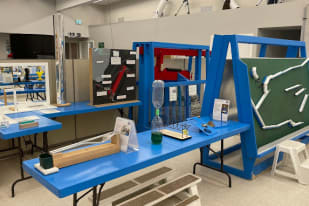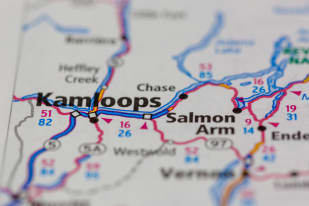Imagine standing on land that holds secrets from over 52 million years ago, where each layer of shale reveals a snapshot of a world vastly different from today. The McAbee Fossil Beds Heritage Site in British Columbia offers this rare opportunity, bringing the distant past to life through remarkably preserved fossils of plants, insects, and fish. The McAbee Fossil Beds provide invaluable insights into ancient climates and biodiversity while exemplifying how science and Indigenous stewardship can protect natural heritage. Visitors can explore its history and actively contribute to its preservation, ensuring this extraordinary resource continues to educate and inspire for generations to come.
From Discovery to Heritage Protection
The McAbee Fossil Beds first came to scientific attention in the late 19th century when geologist George Mercer Dawson recorded fossils in the region. However, systematic study began in the 20th century, with researchers quickly recognizing the site's wealth of information about the Eocene Epoch. In 2012, British Columbia designated the McAbee Fossil Beds as a Provincial Heritage Site, granting it legal protection under the Heritage Conservation Act. This status ensures that the fossils and surrounding land are preserved for research, education, and future generations. Today, the Bonaparte First Nation manages the site, integrating conservation, scientific research, and cultural values to sustain its global importance.
Geological Features and Ancient Origins
The McAbee Fossil Beds were formed during the early Eocene Epoch, approximately 52 million years ago. At that time, a warm and wet climate supported lush vegetation and diverse wildlife, which coincided with significant volcanic activity, creating the perfect fossilization conditions. Ash and sediments from eruptions settled into ancient lake beds, preserving plants, insects, and fish in remarkable detail. A defining feature of the site is the shale's fissility—its natural tendency to split into thin layers. This property allows fossils to be uncovered with extraordinary precision. Alongside fossils, the site also features petrified wood and volcanic landforms, offering a broader geological context. Unique to McAbee, some volcanic formations are not seen at other fossil sites, showcasing how volcanic activity contributed to both fossil preservation and the shaping of the ancient environment.
Fossil Highlights and Scientific Contributions
The McAbee Fossil Beds are known worldwide for their diversity of fossils, providing insights into an ancient temperate rainforest. Fossilized leaves, seeds, cones, and flowers represent plant species related to modern-day maples, birches, and elms. Notable finds include Dipteronia brownii, a plant now native only to China, and Palaeocarpinus, an extinct member of the birch family. The site's insect and fish fossils are equally impressive. Fossils of fish like Amyzon and Eohiodon provide a window into aquatic life. At the same time, insects such as dragonflies and beetles preserve intricate details down to the veins in their wings. These fossils have allowed scientists to reconstruct the climate, suggesting a mean annual temperature of 11°C and over 1,000mm of rainfall, conditions similar to modern temperate rainforests. Recent discoveries have added to McAbee's scientific significance. In 2019, eight previously unknown dragonfly species were described from the site, providing critical insights into ancient biodiversity and evolutionary patterns. In 2021, researchers identified a new insect suborder, Cephalozygoptera, solving a long-standing mystery about dragonfly evolution. McAbee is part of a global network of fossil sites, but its preservation quality and range of species set it apart. By comparing McAbee's fossils to those from other Eocene sites, researchers have uncovered plant and animal evolution patterns that span continents.
Indigenous Stewardship and Cultural Significance
The Bonaparte First Nation plays a central role in managing the McAbee Fossil Beds, ensuring that conservation efforts align with both scientific priorities and cultural values. This stewardship model emphasizes the interconnectedness of natural and cultural heritage, offering a holistic approach to site management. In addition to site management, the Bonaparte First Nation integrates cultural practices and traditions into the preservation process. Oral histories, traditional ecological knowledge, and ceremonial practices help ensure the land remains both scientifically and culturally significant. Since reopening to the public in 2019, visitors have had the opportunity to participate in guided tours and educational programs incorporating scientific knowledge and Indigenous perspectives. These experiences deepen appreciation for the fossils while highlighting the importance of protecting this heritage. Visitors can further contribute to the preservation of the McAbee Fossil Beds by respecting site guidelines, engaging in educational programs, and spreading awareness about its importance.
Conservation and Challenges
Protecting the McAbee Fossil Beds requires rigorous conservation measures. Fossil collection is prohibited without permits, and research activities are carefully regulated to ensure minimal impact. The Royal BC Museum stores Fossils from McAbee, where they continue to support research on early Eocene ecosystems. Despite these efforts, the site faces challenges. Illegal fossil collecting remains a significant concern, risking the loss of irreplaceable scientific data. Additionally, natural erosion, exacerbated by climate change, threatens the integrity of the fossil beds. Balancing public access with preservation is another challenge, as increased foot traffic can strain the site's fragile ecosystem. The Bonaparte First Nation works closely with provincial authorities to address these issues. Strategies include enhanced site monitoring, community education campaigns, and careful management of visitor numbers to reduce environmental impact. Visitors are encouraged to support these efforts by following safety guidelines and participating in community initiatives.
Visitor Experience and Educational Value
The McAbee Fossil Beds offer more than just scientific insight—they are a destination for learning and exploration. Visitors can explore trails, view fossils in situ, and learn about the paleontological process. Educational programs cater to students, families, and researchers, making the site accessible to a wide audience. Guided tours provide a structured way to experience the site while ensuring that visitors respect its conservation rules. These tours often include explanations of how fossils form, the significance of specific finds, and the ongoing efforts to preserve the site. Admission fees for visiting are affordable, ranging from $5 for children to $8 for adults. Group tours are available upon request, and visitors are encouraged to follow safety guidelines while exploring the trails. Public displays of fossils at the Royal BC Museum offer another way to engage with McAbee's legacy for those who cannot visit the site in person. With accessibility in mind, plans are underway to create an interpretive centre featuring interactive exhibits, virtual tours, and educational workshops. This centre aims to deepen visitor engagement and make the McAbee Fossil Beds' significance accessible to a global audience.
Why McAbee Matters Today
The McAbee Fossil Beds are more than just a record of the past—they hold lessons for the present. By studying the fossils, scientists have gained valuable insights into how ecosystems respond to climate change and how species adapt over time. These lessons are increasingly relevant as modern ecosystems face similar challenges. The site's unique combination of scientific importance, cultural stewardship, and public accessibility makes it a powerful tool for education and conservation. Visitors can contribute to preserving this invaluable resource by respecting guidelines, spreading awareness, and actively supporting its preservation. Together, we can ensure that the McAbee Fossil Beds continue to inspire and educate future generations.





